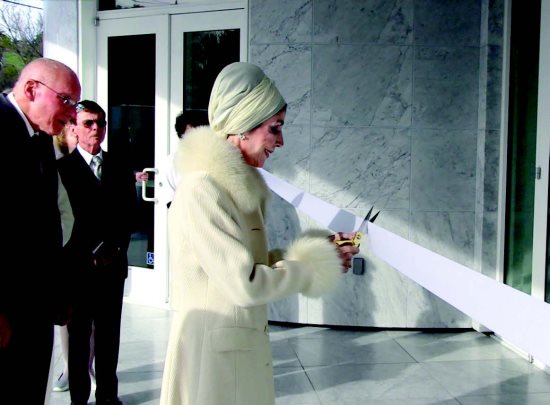
| ||||||
The formal ribbon cutting took place at 3:30 p.m. on Friday, Feb 24, which corresponded to the exact time in India when the group's spiritual leader and founder, Meher Baba, was born.
Their current leader, or Murshida, Dr. Carol Weyland Conner, unveiled a pair of plaques outside the sanctuary and led approximately 350 members inside. In her inaugural address, Murshida Conner stressed the deeper meanings of the sanctuary: "My primary aim was to create a beautiful building as an expression of our worship. In all spiritual traditions, design of a sanctuary strives to give outward material form to the still, sacred space at the center of the human heart."
On Saturday, the self-described nondenominational group celebrated the design, construction and operation of the new sanctuary and honored all those who helped build it. The afternoon presentation focused on one of the groups more important precepts, "Mastery in Servitude." Meher Baba taught that true mastery of life comes through devoting one's life completely to the service of God's world. The program highlighted four of the main ways that the group gives back to the community:
The Meher Schools in Lafayette, created by Murshida Duce in 1975, has provided nonsectarian education to thousands of children.
White Pony Express was created by Murshida Conner to redistribute the abundant surplus of material wealth in Contra Costa County to those in need. The food rescue program picks up close to 5,000 pounds of surplus food every day and delivers it free to those who feed the hungry.
The Free General Store and its mobile boutique has given away 255,000 articles of new or like-new clothing and 92,000 children's books, games, and toys to people in neighborhoods of need.
The renowned Francis in the Schools program was started by Murshida Conner to serve urban neighborhoods of poverty, neglect and abuse. Volunteers create an Umbrian Renaissance Faire for the children and treat them to an afternoon of fun and respect. To date, 12,000 children have attended the programs.
One of the most moving events occurred Saturday, when all the people who worked on the building, along with their families, were invited and honored. Later they saw a 10-minute video presentation of their work. Many of the construction workers were visibly moved by their recognition. One worker who helped with the waterproofing of the underground facilities said, "I've never before been thanked by anyone for the work I've done."
Duncan Knowles, media liaison for the group, said that the marble workers, who lifted pieces of marble weighing 300 to 500 pounds into place, were really proud of their work. "And they should be," said Knowles.
A tour of the facility followed. With approximately two-thirds of the building underground, the sanctuary includes the Prayer Hall, which can seat all 350 members, a 39-foot tall figurative sculpture, a commercial kitchen, offices, an archive room, dance studio, rehearsal room and video space capable of live-streaming their events to the far corners of the world.
Many representatives from the Interfaith Council of Contra Costa County attended the opening festivities.
Still some complaints
The plan to construct the sanctuary caused considerable debate within the Saranap area, and now that it is complete there is still some chirping about it. Residents have complained about the vinyl fence surrounding the property and the large expanse of parking lot. Some don't care for the domes or the plantings they have seen to date.
Sanctuary Project Director Bob Carpenter admits that the fence wasn't their first choice, but the cost of the rock and glass wall they planned became prohibitive. "Our hope is that sometime in the future we'll be able to build the wall the way it was intended."
The original plans also called for a "Grasspave" lawn across the parking area, but the drought and water rationing forced the group to delay that plan. "We did install the Grasspave system," said Carpenter, "so perhaps in the future the water restrictions will be lifted and we can add that lawn."
Regarding the domes, Knowles points out they were not added for outward appearance. "They were installed for the peaceful and exalted feeling people experience inside the sanctuary. Domes create a tranquil, uplifting space beneath them. They've been added to sacred buildings for centuries and can help one's heart awaken for prayer."
Knowles related that the plantings on the outside, especially the trees, may take five years or more to fill in. "They were chosen for how beautiful they'll look when mature. Eventually, the sanctuary will be nestled in a glade of trees, mostly unseen from the street. Murshida Conner's vision is that the area surrounding the sanctuary will become a park with flowered gardens, a place where neighbors and members can come for quiet contemplation."
Reach the reporter at:
